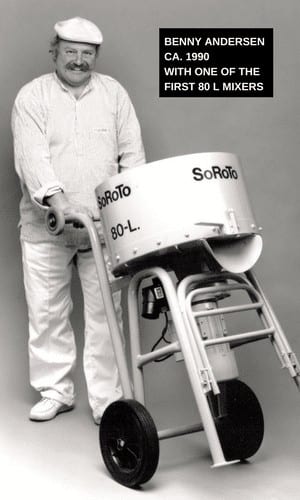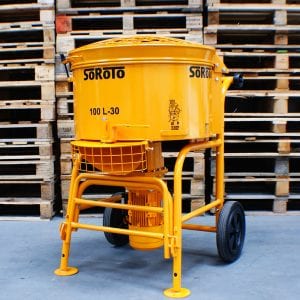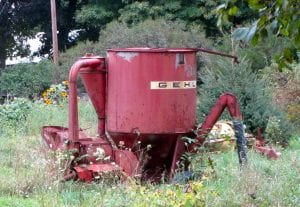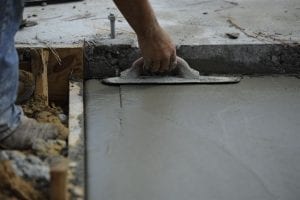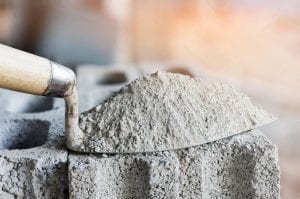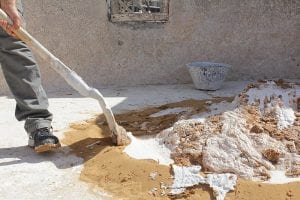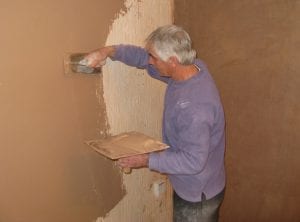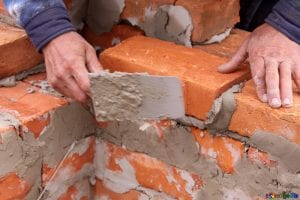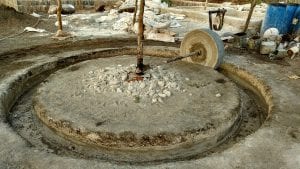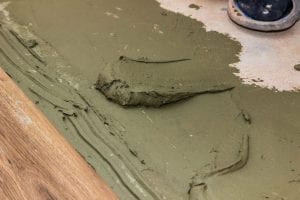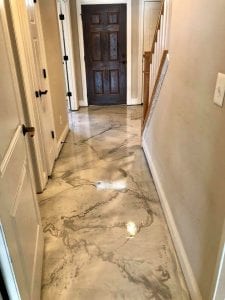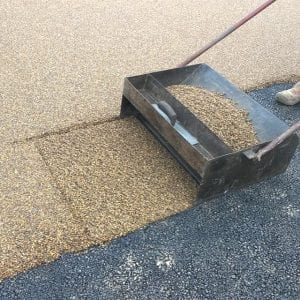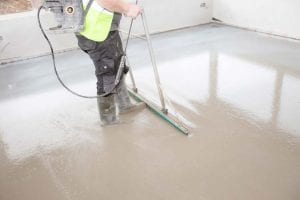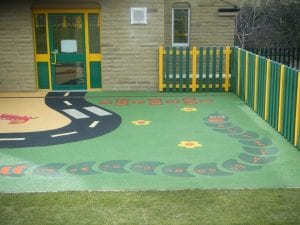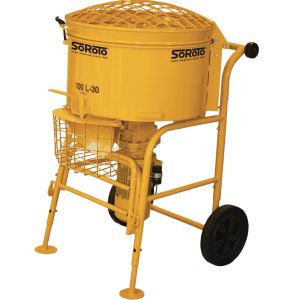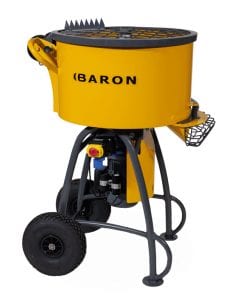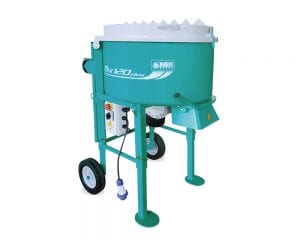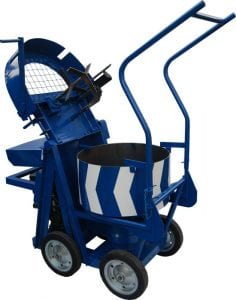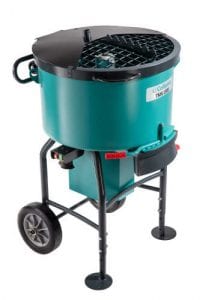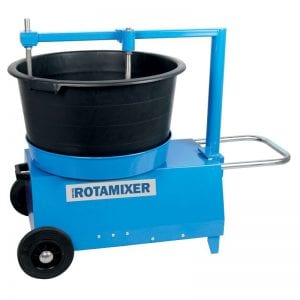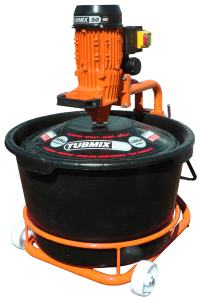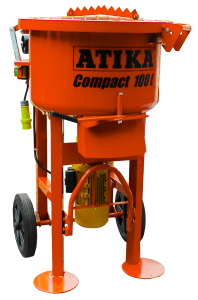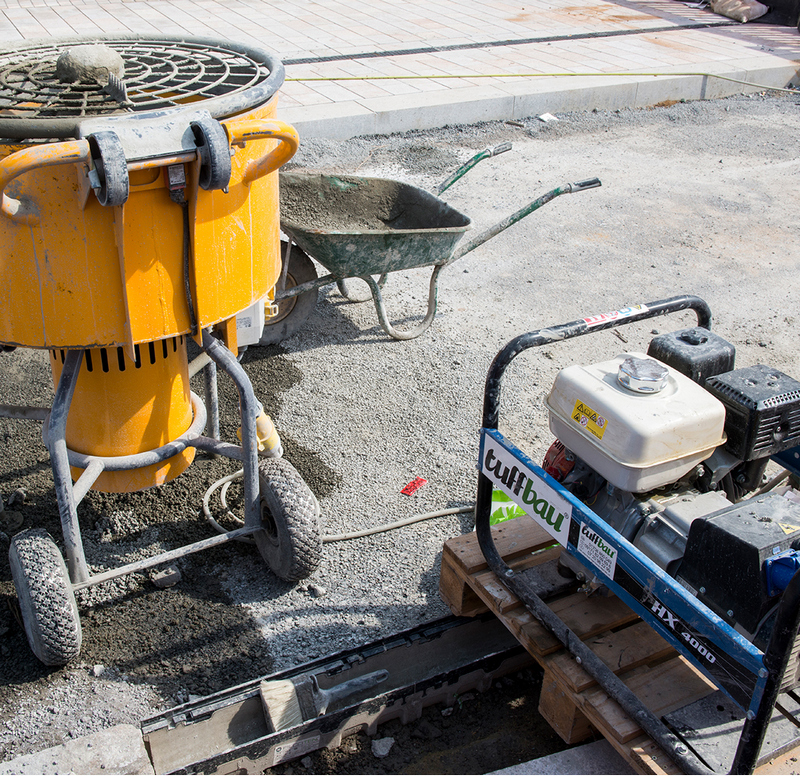Forced Action Mixer .co.uk
History of forced action mixers
Forced action mixers history began in 1983 when bricklayer Benny Andersen decided to construct the mixer that he and his colleagues needed. One for indoor tiling, flooring, concrete renovation, and regular masonry.
The alternative mixers which existed in those days were all big, difficult to handle and ran on a 3-phased current – and the quality of the mix left much to be desired. The new mixer had to be handy; easy to take up-stairs and through doors. And it had to be able to be powered by a regular domestic output…
…To achieve this result, Benny Andersen (founder of SoRoTo), had to disregard all previous mixer constructions to create his own unique mixer variation. After just a few years of intense work he presented his new, groundbreaking design. His first forced action mixer had a mixing capacity of 40 litres, which was the contents of a standard bag those days. It was so well designed that a single man could easily transport the product and it was able to run off a standard power outlet.
The scoop though was the mixing arms that Benny constructed and patented. They secured a perfect mix and could be mounted and removed without the need for tools. One benefit that made his forced action mixer superior to typical single drum mixers was its superior power through the choice of motor and use of gears meaning it could be used on a variety of projects and applications with its shortened mixing time.
The reception from fellow professionals went beyond expectations: the mixer was a sensation. But the Danish craftsmen were busy and soon they sought bigger machines – and they have continued to do so over the years. Today SoRoTo manufacture and distribute forced action mixers of 40, 80, 100, 120, 200 and 300 litres.
Due to the forced action mixers versatility over other products, other manufacturers took this idea and began to further modify the product to suit more specific needs in certain industries such as agriculture.
Read on to learn more about different types of forced action mixers, how they can be used and the different manufacturers of these mixers.
Types Of Forced Action Mixers
There are three variations of forced action mixers. Mixers can powered by electricity, petrol or diesel and in some cases even tractors. All three options work perfectly well but one may suit your needs better than the others.
Below we discuss the performance of each type of mixer as well as the benefits and negatives of different power sourced pan mixers:
Electric Powered
An electric forced action mixer is possibly the most common forced action mixer on the market to date. This type of forced action mixer is replacing the older style diesel powered versions due to their many added benefits to both the user and its surroundings. An electric mixer has a significant weight reduction compared to its diesel counterpart which makes the product more mobile. Even if this mixer is required in a location away from a mains outlet, it can easily be paired with an external power source and extension lead, still reducing your overall carrying weight.
Another benefit of using an electric pan mixer is the reduction in mess produced when in use due to its slow start motor and also the now redundant need to refuel the equipment, therefore, no longer needing to carry a jerry can of fuel around when completing projects. Another great feature of electric forced action mixers is that they are more sustainable for the environment as they do not release carbon into the atmosphere. Choosing this equipment gives you a choice on the size and voltage that suits your businesses requirements without seeing an impact on performance across the range.
Diesel Or Petrol Powered
Petrol or diesel powered forced action mixers or pan mixers were the original choice for most users. They are just like normal electric mixers which we are more used to now but are instead powered through a multi-phase fuel motor instead of electric. Fill up like a car, start the engine, load in your materials to mix and begin your installation.
Typically, diesel or petrol powered machines are larger with large mixing capacities. Used on bigger projects where huge amounts of material need mixing such as industrial concrete projects, resin bound gravel installations and more. There are however small variants such as the CreteAngle CF28 which is a small transportable pan mixer which has a capacity of 52 litres meaning you can have a petrol powered mixer on smaller projects too.
If you think these types of mixers could be ideal for yourself. You can find examples of these types of mixers on the market with between a 5 and 10 horsepower motor which is powered by either petrol or diesel. An example of petrol mixers are from Baron, they currently supply a B150 which is manufactured with a Honda 4.1kW/5.5HP motor and an E300 which is manufactured with a 4.0kW/10HP motor both of which provide plenty of power to mix efficiently.
Despite their many benefits, there are some downfalls to using diesel or petrol forced action mixers. Generally, these types of mixer are much louder than electric mixers and give off fumes whilst in use meaning you are producing air and noise pollution just from working normally. What may seem like powerful mixers are actually producing the same RPMs and material as their electrical counterparts. You must take into account that these machines are powered by non-renewable fossil fuels whereas most other forced action mixers are powered through electricity which can be produced through renewable means.
Tractor Powered
A tractor forced action mixer (also known as a tractor pan mixer) is a product that has additional benefits to a traditional electric or diesel forced action mixer, used within the construction industry. As the name suggests, this product can be attached to the rear of a tractor and can be controlled by two power sources, these being electric or hydraulic. This pan mixer is often used within agriculture enabling farmers to mix and spread certain mixes of feed for animals.
Another great benefit is its ability to cover a larger surface area in a shorter time period, enabling farmers to feed animals or cover fields in less time. These tractor mounted pan mixers are often come in larger sizes than the conventional forced action mixer. Many tractor mixers are constructed to a high standard, and the idea of low cost ownership in mind so that a consumer within the agriculture industry can improve their standard of work without having to worry about cash flow.
Applications
Forced action mixers are incredibly versatile machines which can efficiently mix a wide range of materials. Read on to learn more about just some of the variety of applications which forced action mixers are capable of mixing:
Concrete
Many types of mixer can be used in order to mix the blend of aggregates, sand, cement and water to create a dense construction material known as concrete. This product is used worldwide in the construction industry and it is so hard people have referred to it as ‘artificial rock!’
Concrete has many uses such as creating strong paving, foundations, cladding, posts, floors, cellars, walls, blocks, slabs, reinforcement, roads, paths and more, so choosing a forced action mixer that is reliable and at a capacity that best suits your needs will ensure that your construction needs are not compromised.
Cement
A traditional cement mixer or ordinary drum mixer is the preferred choice of equipment to mix this substance. However, people don’t realise that forced action mixers can be used for a wide variety of applications including concrete, mortar, plaster, tile adhesive and much more.
Due to the forced action mixer’s construction, it means that it can adapt and mix a variety of substances, some that are tough, through the use gears which ordinary cement mixers do not have. Due to the forced action mixer’s superior force, it means that the mixing time of cement is less compared to its ordinary counterpart.
Sand And Cement
Sand & Cement is a type of mortar that is typically used as a binding or fixing material in applications such as laying concrete tiles or creating cementitious materials such as plaster, tiling binder, concrete, mortar and more. Sand & Cement is used when only a small amount is required. A thick layer can start to crack and fall away which is not ideal.
Using a forced action mixer in order to mix the substance is one of the best options due to its high-quality build and reliability; it means it can give you a smooth and consistent mix. Using a poor quality mixer will leave you with a lumpy substance and an unusable material.
Plaster
Plaster is an application typically used on the bare interior walls and ceilings within a property before the decorative layer of paint, wallpaper or tiles can be applied. Plaster can be made from clay, lime, gypsum and Portland cement and mixed together using a top mixer for a fantastic consistent mix each and every time.
Many plasters opt to use a paddle mixer which can leave you with a smooth consistent mix but can have some limitations such as; the amount of plaster that can be produced; an operator needs to operate the product to be used effectively and could be an obstruction when using time-critical products such as resin or tiles, so choosing a pan mixer in the capacity that suits your business requirements you can achieve the same result automatically and with the added benefit of other applications it ensures your business can be ready for any job.
Mortar
Mortar is a workable paste which dries to bind building blocks such as stones, bricks, and concrete masonry units, to fill and seal the irregular gaps between them, and sometimes to add decorative colours or patterns to masonry walls. Mortar is created by mixing together sand, a cement binder and water which creates a viscous material and after time will set meaning a change from a paste to a hard substance.
Mortar is best mixed in a high-quality product to allow a smooth mix before application. A forced action mixer can ensure that mortar is mixed to the best standard and provides you with a top mix each and every time you use it.
Paint
Everyone knows what paint is, a coloured liquid that is applied to paper, pots, walls, ceilings and even the outsides of houses. There is a wide variety of paint available and all have their own unique benefits to suit your project’s needs. These include UV protection, waterproof and scrub resistant and also many products come in variants such as gloss and matte.
One of the fantastic parts of paint is the ability to create your own colours by mixing two or more paints together. Using mainly primary colours you can add colours together before mixing to create attractive and vibrant paints for many uses. Using a forced action mixer, in order to create your paint mix allows you to create large quantities of the paint whilst receiving a great smooth consistency after mixing, ready to be applied to the walls.
Lime Mortar
Lime Mortar is created by mixing together lime putty or powdered lime, aggregate or sand and water to create a pointing. This soft and permeable material allows the any structure movement whilst ensuring that any moisture within the walls can evaporate. A typical lime mortar mix would consist of 1 part lime putty and 3 parts sharp sand or aggregates. Today you will find that this material is mainly used for adding new render or pointing in the conservation of older buildings which would have been originally built using lime mortar or a similar material.
In the past, people have attempted to use cement mortar in place of lime mortar but it has proved to be incompatible with the existing bricks and binding due to being too hard of a material. You will also find that the creamy colours of lime mortar are a better colour match with local sands which are used to create the stones and bricks of buildings. Typically mixed in a concrete mixer or with a hand held paddle mixer, some users are unaware that forced action mixers can efficiently and quickly mix large amounts of lime mortar and prevent repeat trips back and forth from a smaller or slower mixer.
Tile Adhesive
Tile Adhesive is a material typically used to bond and secure tiles for kitchens and bathrooms as well as splash-backs for kitchens. This strong binding material fixes your tiles in place before grout and other similar products are applied to fill or seal the gaps between every tile. You can purchase tile adhesive in either powder bags which are then mixed with water or ready mix bags ready for instant use. It is recommend for best results that you work patiently in small areas to ensure each tile is correctly installed and will not come loose.
The adhesive needs to be combed to ensure each tile has something to grip onto. Most installers opt for the use of hand held paddle mixers which prepare the material in a bucket. However, with smaller forced action mixers you can have a portable and high powered machine which can be used both indoors and outdoors to provide you with a quality mix, creating less mess and which can work on your next batch of material whilst your current batch is being installed.
Epoxy Resin
Epoxy Resin is tough, fast drying, hard-wearing and easy to apply material which provides you with an attractive finish. Used mainly for coating and sealing walls and floors in factories, garages, workshops and so much more, Epoxy Resin is a versatile product which can include multiple colours to create almost any colour or pattern.
This material supplied in two parts which are mixed together to create the hard wearing floor. Mixing the two parts (A the base and B the hardener) will create a liquid which can be poured and levelled before leaving to dry. Many installers choose to use hand held mixers but for large projects using a forced action mixer can be perfect. The mixing motion provided by the arms of forced action mixers will provide you with a quick and efficient mix each time.
Resin Bound Gravel
Resin Bound Gravel is an attractive, strong, permeable, long lasting, low maintenance and non-slip surface which is ideal for creating driveways, pathways, patios, steps, and much more. Increasing in popularity each year, resin bound is created by mixing together an expertly formulated polyurethane-based resin binder (available in either UV stable or non-UV variants) with washed and kiln-dried decorative aggregates (available in a range of colours and sizes) in a forced action mixer.
When laid correctly, in the right conditions and by a good installer, you can have a SuDs compliant resin bound area which can last up to 20 years thank to its strength and flexibility. Mix quality and quantity is incredibly important for resin bound gravel installers which is why forced action mixers are regarded as a necessity. The mixing arms positions and rotary speed ensure that every bit of material is mixed and you will not be left with any dry spots which can be detrimental to the finished product.
Screed
Screed is material which is laid on top of existing flooring such as concrete slabs or concrete floor units. It is a popular choice for installers who want to level and smooth out a floor before laying a top product such as a carpet or tiles. Screed can also be used to protect and cover pipes, under floor heating and insulation. This thin cementitious material is created by mixing together cement, sharp sand and water – similar to concrete.
A smooth mix with no balling or clumping Is needed which is why choice of mixer is very important. Typically concrete mixers are used to create screed buy forced action mixers are better suited to mixing screed. There is a chance that concrete mixers can leave dry spots which is not the case with forced action mixers thanks to their mixing capabilities and you will find that the quantity and speed of the mix is increased too.
Wet Pour EPDM Rubber
Wet pour rubber is an attractive, shock absorbent and safe surface which is traditionally found as the surface of playgrounds, parks and other types of recreational areas. To create wet pour rubber, a coloured EPDM rubber crumb is mixed with a specially formulated rubber resin binder which is mixed in a forced action mixer. Wet pour can be installed as one vibrant colour or multiple colours can be used to create engaging patterns which encourage children to continue their development outdoors.
Typically a two layer surface, wet pour rubber is created using a rubber SBR sub-base before topping with a coloured wet pour rubber top layer. Typically your sub-base is 20mm thick but can vary dependant on the areas critical fall height requirements and the wet pour top layer is around 15mm thick.
Manufacturers
Learn more about all the manufacturers of forced action mixers:
SoRoTo
SoRoTo is a Danish company based in Copenhagen, they have been the original manufacturer of forced action mixers since 1986. Company founder Benny Andersen, whilst working as a bricklayer, realized he lacked a small machine which would be portable and compact enough to use on indoor masonry jobs. To achieve the results wanted, he had to disregard all previous mixer constructions, but never-the-less, he presented his new, ground-breaking design after only a couple of years of intense work. It was a forced action mixer with a mixing capacity of 40 litres, which was the content of a standard bag those days. The reception from fellow professionals went beyond expectations: the mixer was a sensation.
Since then SoRoTo have grown to develop various product ranges. The company design mixers which have portability and durability in mind. Their smallest mixer can be easily moved by one person so that mixing can take place exactly where you are working. Their range of forced action mixers is powerful too enabling their products to be used for a vast array of applications. SoRoTo products are designed to stand a vast array of challenging conditions and their carefully selected gearbox and motors ensure that durability is their main priority to ensure they can survive the harsh settings of construction sites. The SoRoTo forced action mixer range includes the 40L (mixing capacity of 40 litres), 80L (mixing capacity of 80 litres), 100L (mixing capacity of 100 litres), 120L (mixing capacity of 120 litres), 200L (mixing capacity of 200 litres) and 300L (mixing capacity of 300 litres).
The more than 30 years of experience within the company, as well as the practical knowledge of the construction industry, makes a solid foundation on which their CEO, Hans Terney Rasmussen, continues to build on.
The great benefit of SoRoTo is that there model numbers match their mixing capacity, therefore, in a nutshell you get what you pay for which other competitive brands do not clearly specify clearly to its consumers. SoRoTo machines all come with a 24 month warranty giving its customers peace of mind.
Baron
Baron are a Danish company based in the city of Børkop, which was established in 2006 when two companies, Baron and AK Products, were merged by their owners to create Baron A/S. Baron say they have shown impressive development and growth since 2006 and continually develop their forced action mixers and other products in collaboration with professional users whilst maintaining a focus on ergonomics and health & safety. In 2016 a new co-owner was introduced with further investment to help the company develop the quality and functionality of their products whilst strengthening their brand in both Denmark and export markets.
Baron claim that their brand “is the absolute market leader” within the forced action mixer industry. Until recently Baron had two different series of forced action mixer, the E and M series which included the M110, E120 and E200. Baron then released their new F-Line forced action mixers which include the F80 (mixing capacity of 59 litres), F110 (mixing capacity of 78 litres), F200 (mixing capacity of 160 litres) and F300 (mixing capacity of 160 litres). Their new forced action mixer F-line has a new exclusive design, is easy to maneuver, has a strong construction and has an easy to clean motor cover to protect against soiling.
Baron and SoRoTo are typically the two choices for forced action mixers in the UK so it will be interesting to see how the F-Line compares to previous series and competitors.
Baron are the market leader for the forced action mixer market. They offer a 12 month warranty across their range of highly built forced action mixers.
Imer
Imer was founded in 1973 from a union of two companies, Poggibonsi and Certaldo which were companies in neighbouring areas and had similar production. From this moment on, IMER’s brand was a series of “unions”, which plotted the path which has led the company to be one of the leading European industrial Groups in the building machine production sector, with 4 specialized divisions and a global presence. Imer produces a range of forced action mixers to suit a variety of projects in the construction industry.
Their range of mortar mixers, as the brand commonly refers to these products as, comes in a variety of sizes and power options. Their largest mixer can be towed on the back of the vehicle for easy movement with their smallest mixer available for single-operator use and movement by hand. The product offers a wide range of applications mainly specializing in mortar mixing and offers the characteristics of a traditional forced action mixer.
Imer customers often praise their range of mixers for great build quality. Imer also offers a 1 year warranty on their range of forced action mixers.
CreteAngle
Creteangle are a UK company based in Worthing who design and manufacture their own range of forced action mixers which meet BSI Protocol and are CE marked for worldwide sale. Creteangle pan mixers were first developed in 1956 and greatly improved the quality and speed of mixing concrete. Since then, their range of mixers has grown and developed with easy to operate and efficient models which are able to mix between 14 and 225 litres per batch.
Creteangle state that their mixers are “renowned throughout the world for their sure, fast and easy mixing process used for concrete testing, production and anyone mixing resin based materials.” Each of the mixers includes their unique multiflow mixing process which is achieved due to the design of the mixing arms which are attached to the lid of each machine and the fact that the pan of their mixer spins not the arms like other mixers. Their current range includes the S, CF 28, CF35, LE Standard, L Heavy Duty, L 112, M, M Hydraulic, FE and TEC225.
CreteAngle can be powered by petrol/diesel meaning no generator or cables are required to power the machine. CreteAngle offer a 1 year warranty on their range of pan mixers.
Collomix
Collomix was founded in 1974 and they specialize in mixing and tinting products for the construction industry. Collomix produces a handheld mixer for smaller projects but a heavy load. This mixer can work with variables such as plaster, concrete, and mortar.
Collomix offers various sizes of their handheld mixer which all have their own maximum mixing capacity, so there is a product to suit a business’s requirements. Their duo range offers the maximum capacity in handheld mixing which has a maximum of up to 90 litres, model dependant. Collomix also offers its collomatic range of forced action mixers which have a maximum capacity of 120 litres. These products are transportable, upright and height adjustable and come in a variety of sizes to accommodate a trader’s requirements. These products can be used in a variety of applications listed here.
Collomix products are specifically designed for mortar mixing, hence the name. Collomix offer a 2 year warranty on their range of mortar mixers.
Refina
Refina are another UK company who are based in Dorset who produce their own compact forced action mixer range all of which include a rotating replaceable plastic drum and technically designed stainless steel paddles which generate radial and axial actions for a quality mix. Incorporated in 1997, Refina has been involved in the market for a number of years and continue to develop and improve their versatile mixers.
Aiming at contractors who work with smaller amounts of material, the largest mixer is only able to mix up to 75kg in one batch but this works well for certain projects. The uniquely designed forced action mixer is easy to clean, required almost no maintenance but does need its plastic mixing tub to be replaced periodically. Their range includes the MR30, MR40, MR65 and MR90.
Refina mixers are extremely cost effective and cheap to maintain. Refina offer a 1 year guarantee on their range of pan mixers.
Altrad Belle
Altrad Belle is an established manufacturer of light equipment for the building and construction markets. Based in the Derbyshire Peak District. In 2009 the company became part of the Altrad Group, with its headquarters in Montpellier, France. They offer a diverse product range for the construction industry such as scaffolding, wheelbarrows and cutting products but also produce 2 varieties of paddle mixers.
They offer their handheld paddle mixer and their stand-alone. Their stand-alone forced action mixer has a capacity of mixing 50 litres and comes with the option of 110V or 230V depending on a client’s needs. Their handheld mixer is offered with the same voltage options and can be able to mix up to 200L of substance. These forced action mixers are durable and heavy-duty and able to mix a wide variety of applications, some of which we have discussed above.
The Altrad Belle Tubmix 50 is great as it can be used for hands-free operation. Belle also offer a 3 month warranty on their product.
Atika
The Atika compact and robust 100 is a multi-purpose forced action mixer which is able to mix up to 80 litres of material. The Atika has been developed over the years to include a heavy-duty motor and gearbox to increase durability and lower its power consumption.
The unique design also allows this mixer to be transported in small vans and even estate cars whilst being able to fit through standard doorways. Its offset mixing arms and 3 way mixing mechanism guarantees fantastic mixing results each and every time it is used. Belle say their forced action mixer is ideal for painters, floor and tile layers and plasterers.
The Atika design makes this machine easy to fit through doors and their product comes with a two year warranty.
